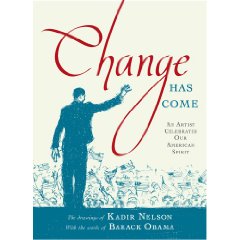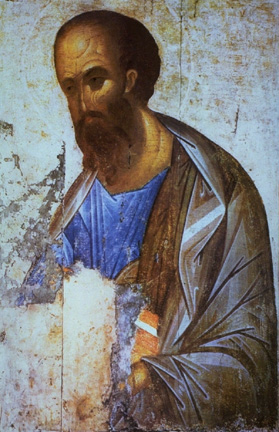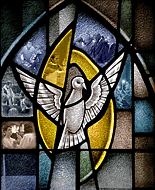I was at Barnes & Noble on Pico yesterday, browsing with a generous Christmas gift card in my pocket. I came across a small book:

Change has come: An Artist Celebrates Our American Spirit, Drawings by Kadir Nelson with the Words of Barack Obama (Simon & Schuster, 2009).
As I leafed through its few illustrated pages I got an idea. I would buy a copy and then from that moment through Inaguration Day, I would ask everyone I met to sign their name, the city, and date as a way to commemorate this incredible moment in our history: our first African-American president. This is incredibly awesome and moving.
The sketches in the book are light and flowing, the line simple. Obama’s words are taken from five of his speeches, from 2004 to Election Day, 2008. They are for any day and all seasons.
First I asked the man who sold the book to me to sign it; he did so very willingly. When I got home yesterday I asked the sisters in my community to sign it and they did.
Then today, when I went to the photo shop to pick up a video/DVD that the owner had transferred for me, I asked him to sign it. He did. We got to talking about what this moment means, what we believe in, and how change needs to continue. I mentioned my hope and prayer that people will respect life more, seamlessly, because if we respect people regardless of their race, we acknowledge human dignity. This belief and respect is the beginning of a renewed perspective on the value of life and can give us the hope to choose life, always. Hope for life, based on how we honor human dignity, can trickle up, down, and all over, and transform our hearts. Our hope.
Then Matt said, “There are 6 billion people on the earth. Every day I try to do something to make the world a better place, 1/6 billionth percent better. I want to do my part.”
Indeed.
When I finish collecting signatures (I am traveling to Dayton, OH, for a meeting and there will be people from all over there) I will treasure the book for a while and then give it to one of my young nephews as a memento of the most unique historical day ever in our U.S. history.
Of course, when we get our first woman president, I will be able to say the same thing. That will be the next chapter.
As I drove home from the photo shop, I thought, “1/6 billionith” of a difference every day. I can do this. Today is Martin Luther King Jr. Day of Service – perfect for 1/6 billionith of difference a day.
Then I thought about the Jewish idea of tikkun olam: working together to heal the world. And then Jesus’ words in the Beatitudes as recorded in the Gospels of Matthew (5:3) and Luke (6:20). Blessed are the poor in spirit, the meek, the humble. These are not passive words, but active and full of life; they embody the joyous dynamism of discipleship. The best of every religion. Working together to heal the world, to make a difference, to make the world a better place for each person, unconditionally.
Thank you, Matt, for the inspiration. Now for the change that hope brings.
1/6 billionith of difference a day.
May the Obama administration be the change we want to see in the world – because that change is us. All of us.
January 20, 2009
Categories: Books . . Author: Sister Rose . Comments: 1 Comment











 Owen Wilson and Jennifer Aniston in Marley & Me
Owen Wilson and Jennifer Aniston in Marley & Me

You must be logged in to post a comment.